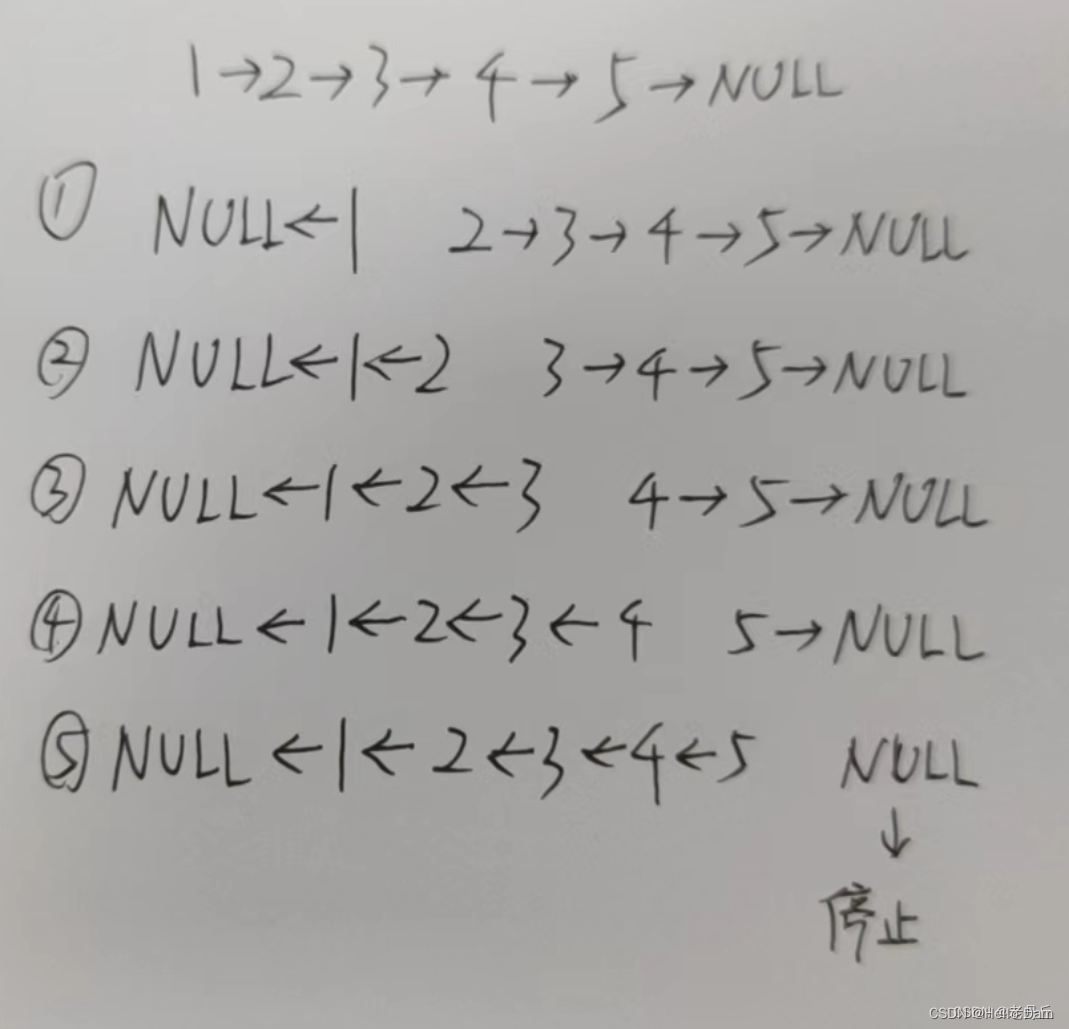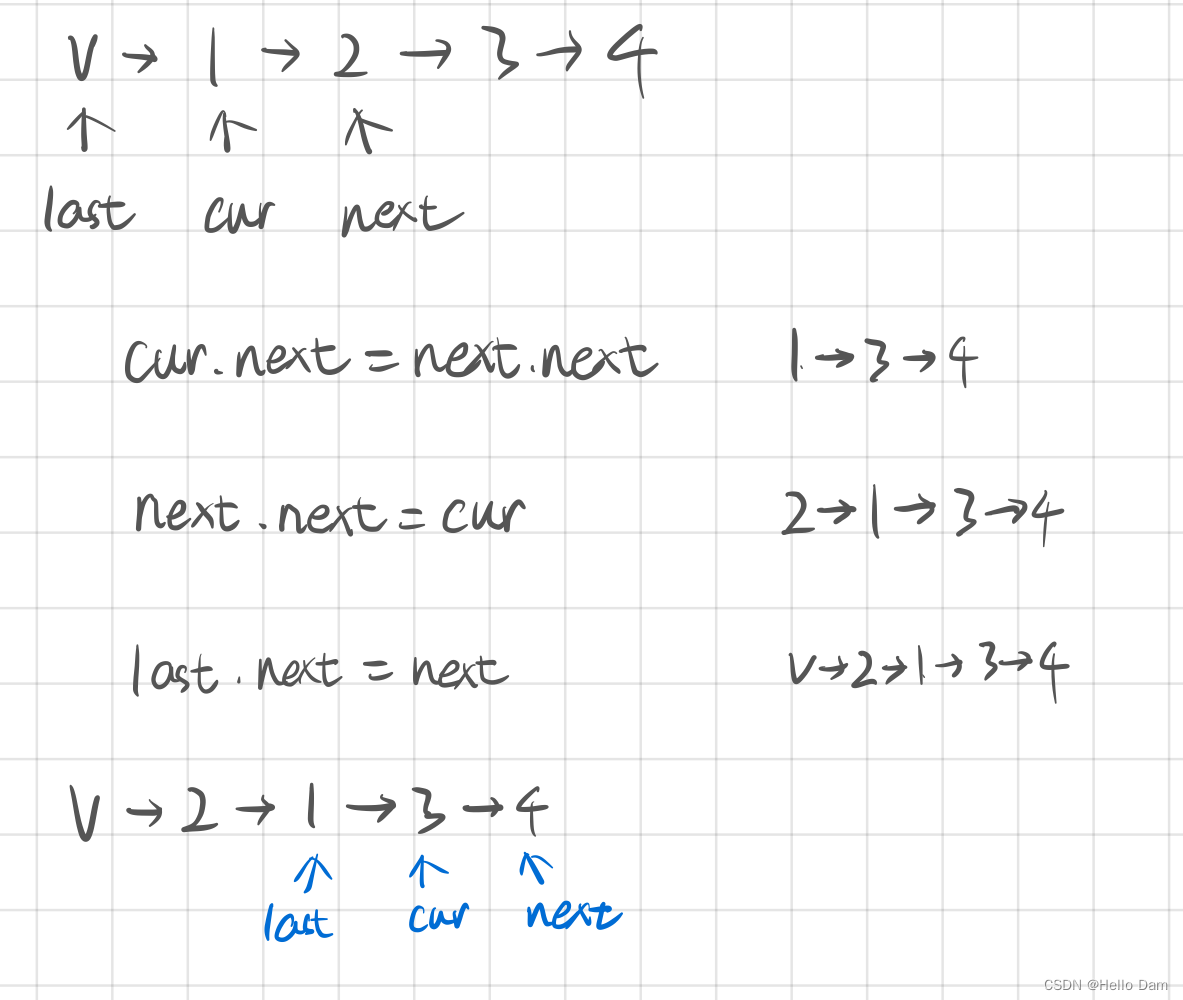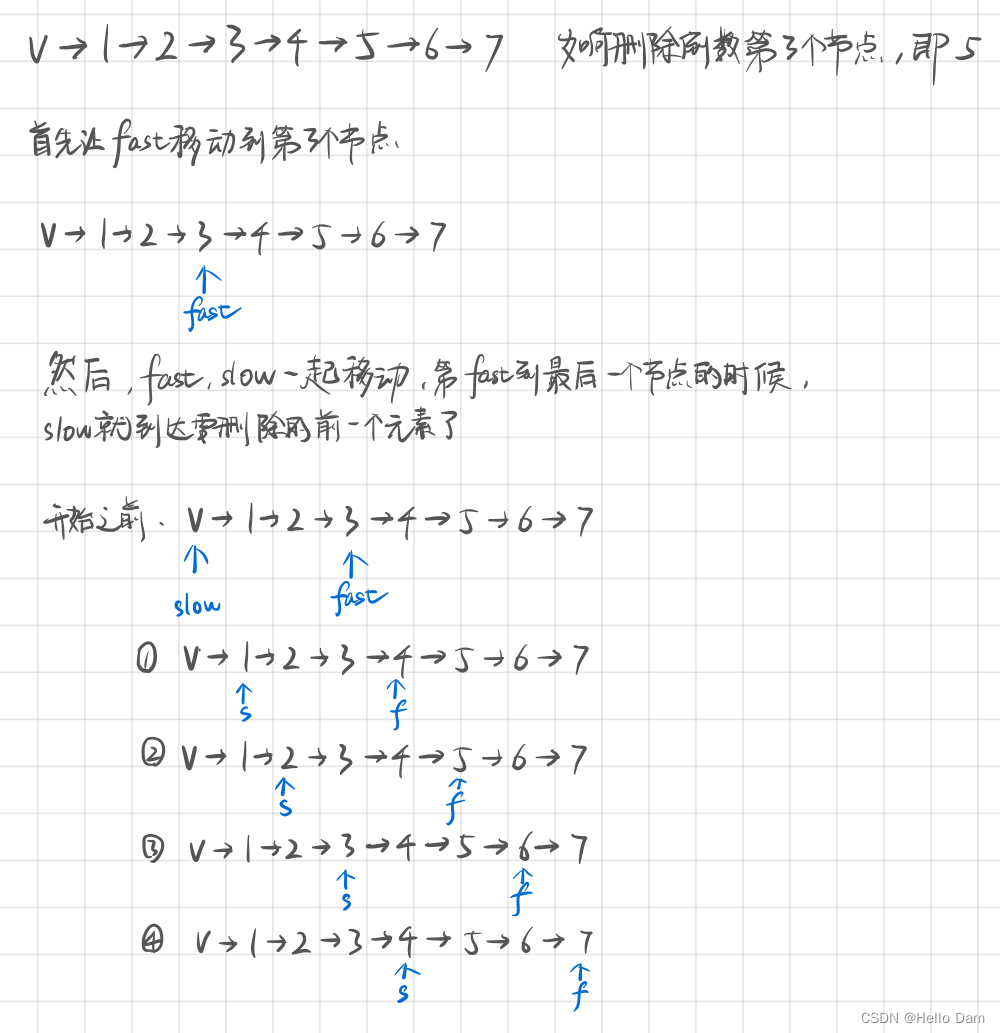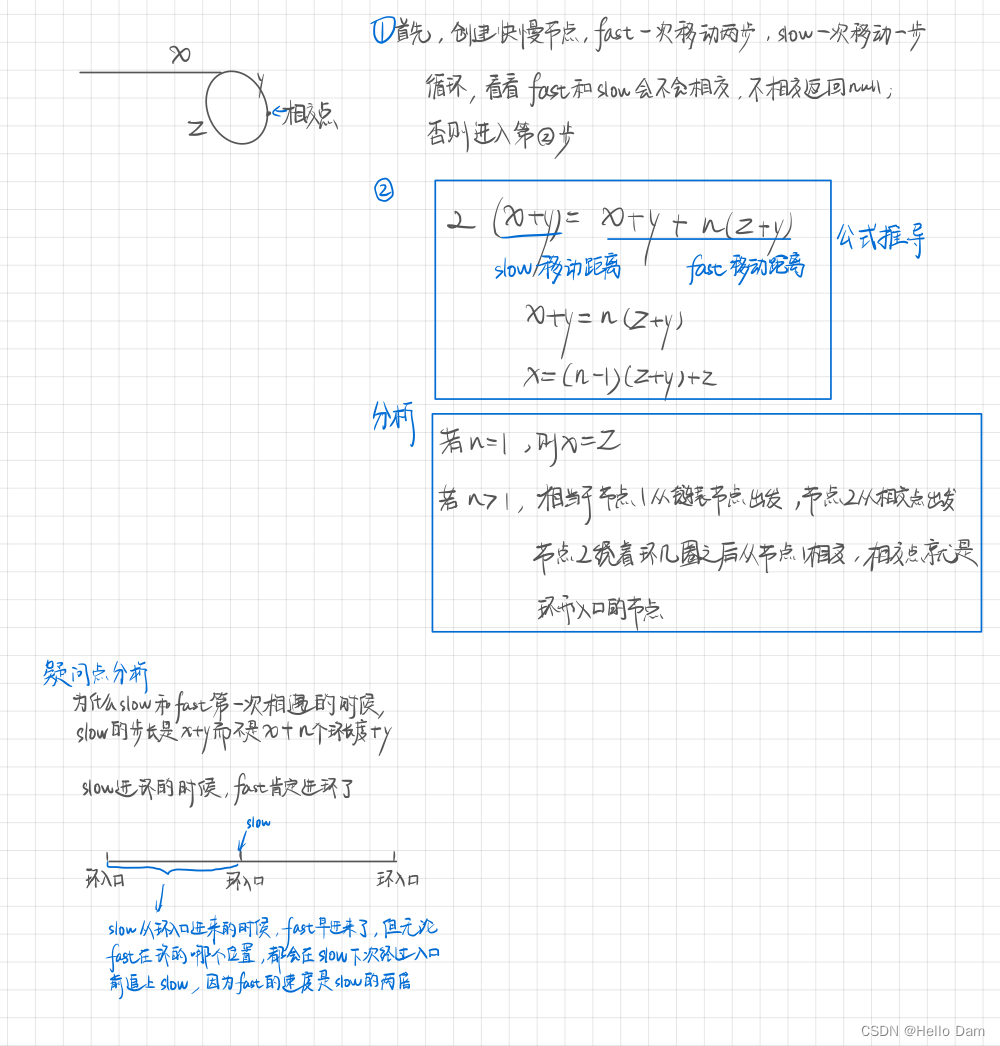链表节点定义
public class ListNode {
// 结点的值
int val;
// 下一个结点
ListNode next;
// 节点的构造函数(无参)
public ListNode() {
}
// 节点的构造函数(有一个参数)
public ListNode(int val) {
this.val = val;
}
// 节点的构造函数(有两个参数)
public ListNode(int val, ListNode next) {
this.val = val;
this.next = next;
}
}
*移除链表节点
题目链接:https://leetcode.cn/problems/reverse-linked-list/
【思路】
有时候增加一个虚拟节点,可以让后面的操作都一致
public static ListNode removeElements(ListNode head, int val) {
if (head == null) {
return null;
}
// 增加一个虚拟节点
ListNode virtualNode = new ListNode();
virtualNode.next = head;
ListNode cur = virtualNode;
ListNode next = cur.next;
while (next != null) {
if (next.val == val) {
cur.next = next.next;
} else {
cur = next;
}
next = cur.next;
}
return virtualNode.next;
}
*反转链表
双指针法
- 时间复杂度: O(n)
- 空间复杂度: O(1)

public static ListNode reverseList(ListNode head) {
ListNode cur = head;
ListNode pre = null;
ListNode temp = null;
while (cur != null) {
temp = cur.next;
cur.next = pre;
pre = cur;
cur = temp;
}
return pre;
}
递归法
- 时间复杂度: O(n)
- 空间复杂度: O(n)
这里的逻辑和双指针法的逻辑是一样的,只是实现方式是递归,那为什么空间复杂度更高呢?
答:因为递归本质上是一种函数调用,在每一次递归调用时,都会在函数栈中分配一段内存空间来保存函数的局部变量、返回地址以及参数等信息。因此,递归实现相对于循环实现的空间复杂度更高,会占用更多的内存空间。尤其是在递归深度较大的情况下,可能会导致栈溢出等问题。而使用循环实现通常不需要使用额外的栈空间,因此循环实现的空间复杂度比递归实现要低
public static ListNode reverseList1(ListNode head) {
return reverse(null, head);
}
public static ListNode reverse(ListNode pre, ListNode cur) {
if (cur != null) {
ListNode temp = cur.next;
cur.next = pre;
pre = reverse(cur, temp);
}
return pre;
}
*两两交换链表中的节点
https://leetcode.cn/problems/swap-nodes-in-pairs/
- 时间复杂度:O(n)
- 空间复杂度:O(1)

public static ListNode swapPairs(ListNode head) {
// 如果链表中没有元素 或者 只有一个元素,直接返回就行
if (head == null || head.next == null) {
return head;
}
// 增加一个虚拟头节点
ListNode virtualNode = new ListNode();
virtualNode.next = head;
ListNode last = virtualNode;
ListNode cur = head;
ListNode next = cur.next;
ListNode temp = null;
while (next != null) {
// 交换
temp = next.next;
cur.next = next.next;
next.next = cur;
last.next = next;
// 指针移动到新的位置
last = cur;
cur = temp;
if (cur != null) {
next = cur.next;
} else {
break;
}
}
return virtualNode.next;
}
*删除链表的倒数第N个节点
https://leetcode.cn/problems/remove-nth-node-from-end-of-list/submissions/
快慢指针法

/**
* 让快指针比慢指针先移动 n 步
*
* @param head
* @param n
* @return
*/
public static ListNode removeNthFromEnd(ListNode head, int n) {
ListNode virtual = new ListNode();
virtual.next = head;
// 让快指针先移动到n个节点
ListNode fast = virtual;
for (int i = 0; i < n; i++) {
if (fast.next != null) {
fast = fast.next;
}
}
// slow和fast一起移动,等fast到达最后一个节点的时候,slow也就到达了要删除的节点前面的节点
ListNode slow = virtual;
while (fast.next != null) {
slow = slow.next;
fast = fast.next;
}
// 执行删除操作
slow.next = slow.next.next;
return virtual.next;
}
- 时间复杂度: O(n)
- 空间复杂度: O(1)
*链表相交
https://leetcode.cn/problems/intersection-of-two-linked-lists-lcci/
注意点
并不是判断val相等,而是hashcode相等
暴力求解
直接两重循环,循环两个链表
- 时间复杂度:O(n^2)
- 空间复杂度:O(1)
进阶解法
利用题目中的信息,已经是链表的尾部才有可能相交,可以先让一条链表前进 两条链表长度差值 的位置,最后再两条链表一起前进

public ListNode getIntersectionNode(ListNode headA, ListNode headB) {
ListNode cur1 = headA;
ListNode cur2 = headB;
int sizeA = 0;
int sizeB = 0;
// 统计链表A的长度
while (cur1 != null) {
sizeA += 1;
cur1 = cur1.next;
}
// 统计链表B的长度
while (cur2 != null) {
sizeB += 1;
cur2 = cur2.next;
}
// 回到初始位置
cur1 = headA;
cur2 = headB;
// 先让元素较多的链表的指针移动一段距离
if (sizeA > sizeB) {
// 链表A的元素较多,先走一段距离
for (int i = 0; i < (sizeA - sizeB); i++) {
cur1 = cur1.next;
}
} else if (sizeA < sizeB) {
for (int i = 0; i < (sizeB - sizeA); i++) {
cur2 = cur2.next;
}
}
// 两个链表同时走动
while (cur1 != null && cur2 != null) {
// 注意,需要的是hash值
if (cur1.hashCode() == cur2.hashCode()) {
return cur1;
}
cur1 = cur1.next;
cur2 = cur2.next;
}
return null;
}
- 时间复杂度:O(n + m)
- 空间复杂度:O(1)
*环形链表
https://leetcode.cn/problems/linked-list-cycle-ii/

public static ListNode detectCycle1(ListNode head) {
if (head == null) {
return null;
}
ListNode slow = head;
ListNode fast = head;
ListNode node2 = null;
// 先找到相交点
while (slow != null && fast.next != null) {
// slow移动一步
slow = slow.next;
// fast移动两步
fast = fast.next.next;
if (slow.hashCode() == fast.hashCode()) {
// slow 和 fast相交
node2 = slow;
// 让node1从起点出发,node2从相交点出发,当node1和node2相交的时候,相交时的节点即环的入口
ListNode node1 = head;
while (true) {
if (node1.hashCode() == node2.hashCode()) {
return node1;
} else {
node1 = node1.next;
node2 = node2.next;
}
}
}
}
return null;
}
- 时间复杂度: O(n)。因为快慢指针相遇前,指针走的次数小于链表长度;快慢指针相遇后,两个node指针走的次数也小于链表长度,因此走的总次数小于 2n
- 空间复杂度: O(1)